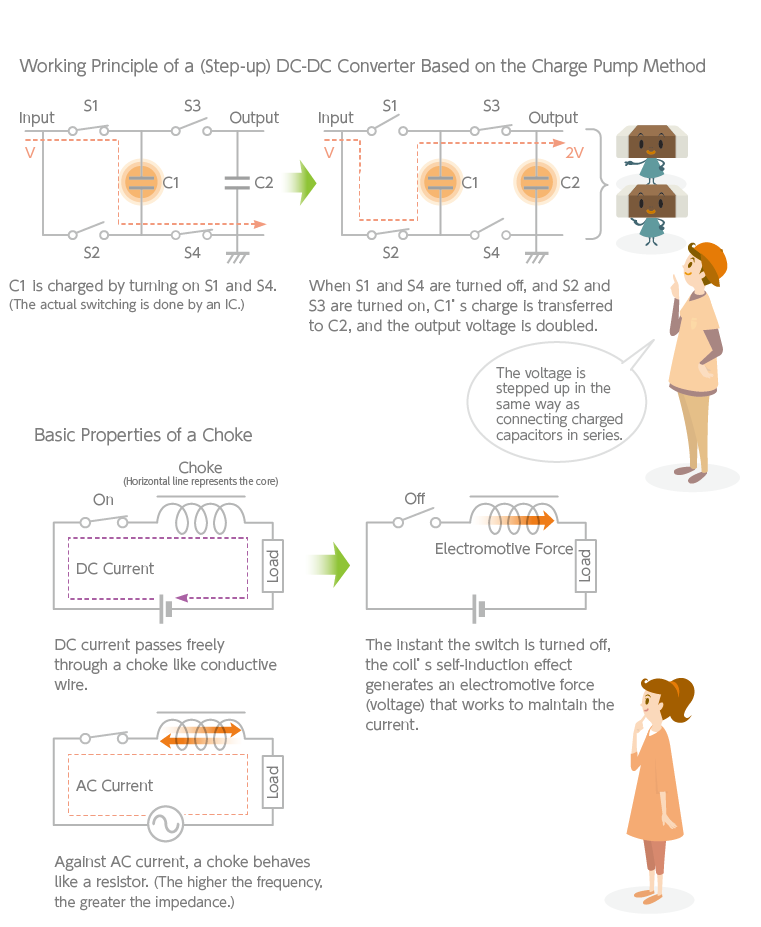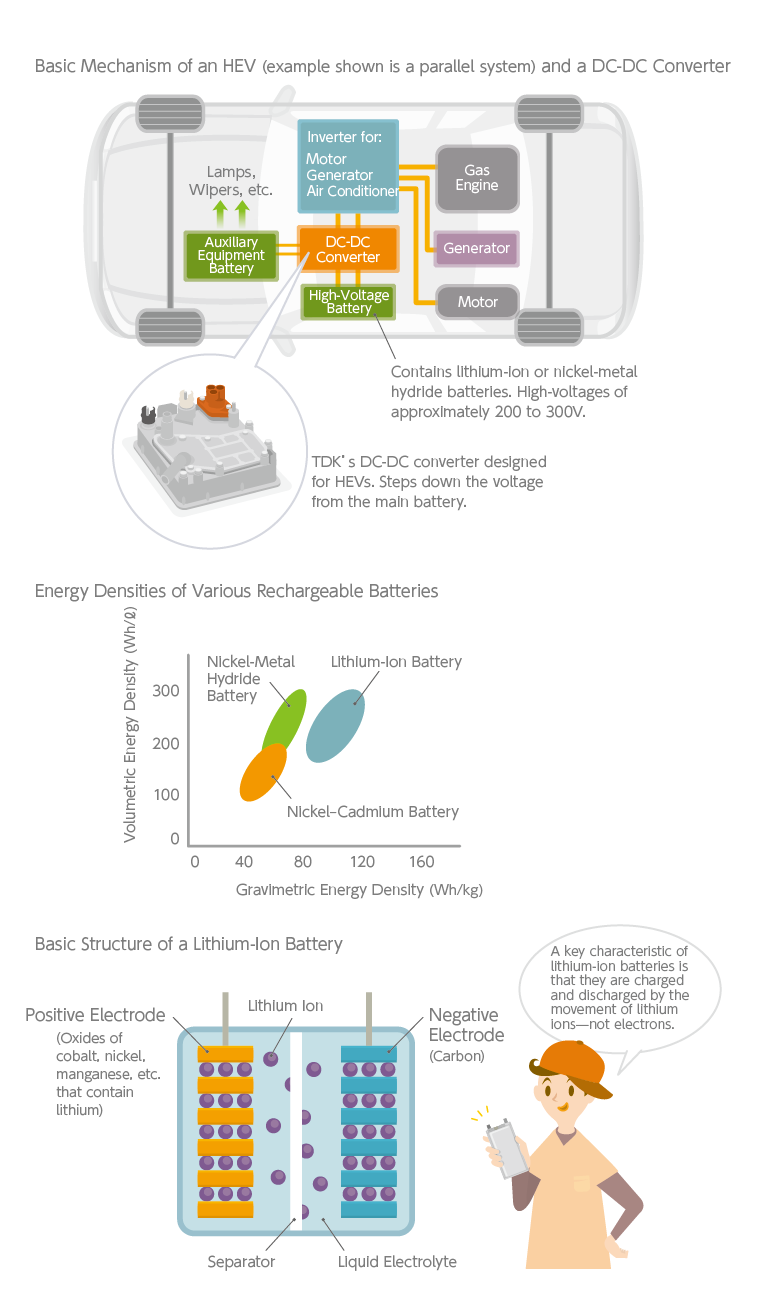The World of Power Electronics
Part 8: Environmentally Friendly, Compact and Lightweight—UPS has Entered the Era of Lithium Batteries

A microwave oven, an electric heater, a vacuum cleaner... multiple electrical appliances are turned on at the same time, and the circuit breaker trips. Power to your PC is gone, and so is the data you were just working on. Many of us have had this unfortunate experience. The same can occur with a sudden power outage, a lightning strike or a power line accident. For an office building or an entire region, the impact of even a momentary power outage can be immense. Uninterruptible power supply (UPS) systems can quickly provide backup power for problems like these.
Capacity and endurance are the key considerations when choosing models
Electrical power is the lifeblood of today’s ceaselessly running society. A blackout would be like a loss of blood—it would amount to a paralysis of society’s nervous system in this age of extensively networked IT systems. A UPS is a device that supplies power from a charged, high-capacity battery to prevent computers, servers, and other equipment from going down in the event of a power failure.
Just like automobiles—which range from compact, standard and large passenger cars to vans and large buses—there are various types of UPS systems depending on capacity, endurance time, circuit design, and physical shape. When planning for a UPS, the first considerations are the power requirements of the equipment you want to protect and the desired endurance (30 minutes, 60 minutes, 2.5 hours, 3 hours, etc.).
For the home, a capacity of several tens of watts to several hundred watts usually suffices. For small-scale needs—where perhaps an Internet connection and a front door intercom are all that need backing—compact, lightweight UPS units based on lithium-ion batteries starting with a capacity of 50W and an endurance of 30 minutes are available. For SOHO and small-scale offices, where multiple PCs and networked servers need coverage, a UPS of around 1000W or more would likely be required. In terms of size and shape, there are desktop types, rack-mountable units which are expandable with minimal space requirements, and floor-mounted types with wheels.
Large offices, communication facilities, public facilities, financial institutions and hospitals will require large-scale, stationary UPS systems (10kVA to 1000kVA in capacity) with three-phase 200V inputs. These systems are weighty due to the sheer number of batteries needed, and are as large as vending machines. Emergency diesel engine generators are often installed in tandem to prepare for cases when the duration of the power outage exceeds the endurance of the UPS.
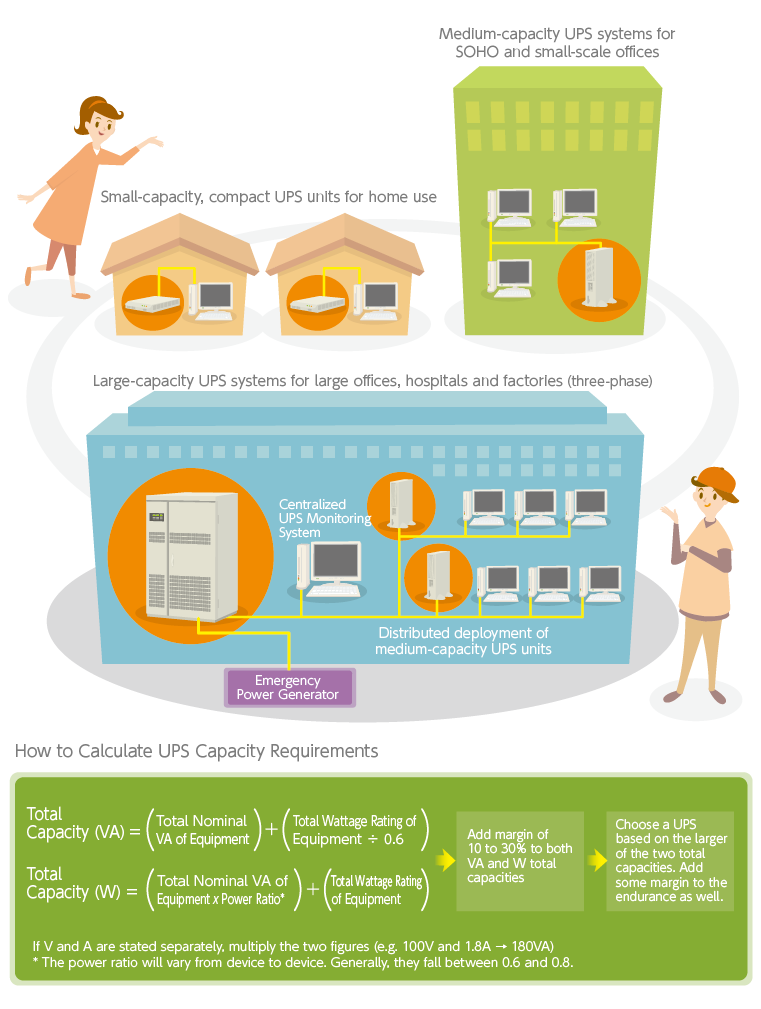
TDK-Lambda’s Lithium UPS satisfies users in one fell swoop
A UPS consists of a rectifier (for AC-DC conversion), a battery (lead-acid, lithium-ion, etc.) and an inverter (for DC-AC conversion). Various UPS circuit designs exist, but the major ones are offline/standby, line-interactive, and online/double-conversion.
Offline/Standby
This is the simplest design. During normal operation, commercial AC power input is passed to output as-is, while the battery is charged with DC power created through the rectifier. When a power failure occurs, the inverter is activated, converting the battery’s power into AC and supplied to output. The voltage waveform is usually a square wave, because devices like PCs are equipped with switching power supplies which do not require the input to be a sine wave resembling commercial AC power. This design is common among UPS units meant for personal use.
Line-Interactive
This is an improved version of the offline/standby design. It features a transformer-based automatic voltage regulation (AVR) circuit that automatically compensates for fluctuations in the input voltage. The output waveform can be either a square wave, or a sine wave like commercial AC power.
Online/Double-Conversion
In both designs above, when the power source is switched in response to a power failure, the output is suspended for an extremely brief moment. This is called an instantaneous interruption. The Online/double-conversion design eliminates this interruption, continuously providing the same frequency and waveform as commercial AC power even when the switch is made. This is achieved by constantly supplying the output through the inverter, while the rectifier charges the battery in parallel. When a power outage occurs, no instantaneous interruption takes place—a stable power output is always available. While the overall power consumption of the UPS is slightly higher due to the constantly-running inverter which incurs some power loss, the design features the ability to easily extend endurance by adding batteries. Most medium to large-scale UPS systems adopt this basic design.
In the past, lead-acid batteries were commonly used in UPS systems. Leakage is not a concern because they are sealed, but they have the drawback of being large and heavy. Worse, lead is an environmentally harmful substance. Therefore, they are gradually being replaced by smaller, lighter, and more environmentally friendly lithium-ion batteries. They tend to be higher-priced than lead-acid batteries, but their much longer life lowers total costs in the long run.
TDK-Lambda strives to lead the new generation of lithium-based UPS systems, continually refining its wealth of technologies and know-how. Rigorous safety measures are implemented in TDK-Lambda’s UPS products, enabling worry-free deployment. Even large-capacity, stationary UPS systems are expected to become much lighter, smaller, and convenient.
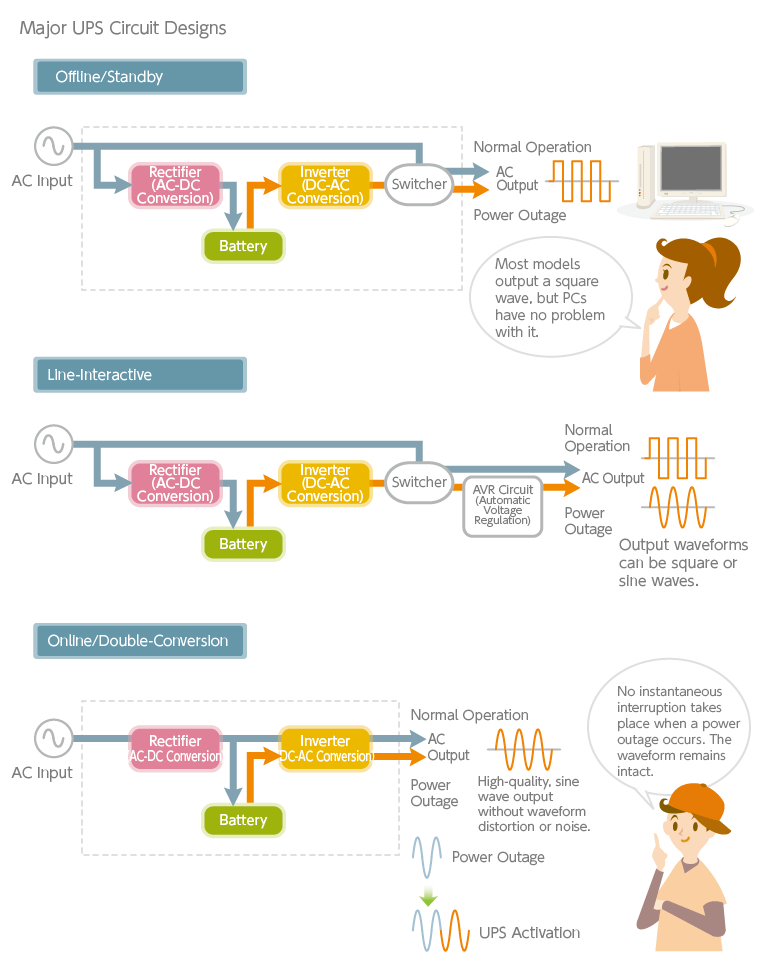
UPS technologies contribute to high-quality, highly efficient power management
Power outages are not the only kind of power disruption. On a daily basis, the sine wave of commercial AC power can become distorted for any number of reasons, adversely affecting electronic devices that draw power from it. A UPS is a highly effective countermeasure against such power anomalies.
TDK-Lambda offers a wide range of UPS products, where power disruptions are classified into nine categories. The type of circuit design used in each model is determined by the categories of disruption it can handle.
Level 3
(1) Power outage: Power interruption due to lightning, natural disasters, human error, etc.
(2) Voltage sag: A phenomenon where the voltage drops momentarily when a substantial load like a large machine is turned on, or due to a commercial power line failure.
(3) Voltage surge: A phenomenon where the voltage instantaneously rises to above 110% of the nominal rating due to a sudden decrease in load, such as a substantial load being turned off or switched.
Level 5
(4) Voltage drop: A phenomenon where the input voltage drops when the capacity of the load side increases due to other connected devices, or when anomalies in the commercial power input occur.
(5) Overvoltage: If the power is drawn near a power generator like an engine-driven generator, the input voltage is constantly supplied at a higher level.
Level 9
(6) Noise in commercial AC power: Noise generated in other devices conducts and infiltrates through the input line. To prevent this, UPS systems are equipped with EMC filters designed for power supplies.
(7) Frequency fluctuation: Occurs when power generation equipment such as an engine-driven generator becomes unstable.
(8) Switch noise: A phenomenon where the input voltage rises momentarily due to power switches being turned on and off. It typically lasts for 9 to 10 seconds, which is shorter than spike noise.
(9) Harmonic distortion: Generated by nonlinear loads such as switching power supplies, variable-speed motors, copiers and fax machines.
The higher the level, the higher the tolerance to power supply disruptions, and the higher the quality and reliability of the output. For personal use to protect a home computer from going down during a power outage, a compact, level 3 model would be sufficient. If robust over-the-network management capabilities and expandability are priorities, a level 5, line-interactive system would be appropriate.
The utilization of natural energy sources such as solar and wind power is moving into the mainstream. UPS technologies are essential for power management tasks like the smooth and efficient switching between batteries and commercial AC power. TDK-Lambda’s lithium-based UPS products powerfully back up clean energy systems of the future.
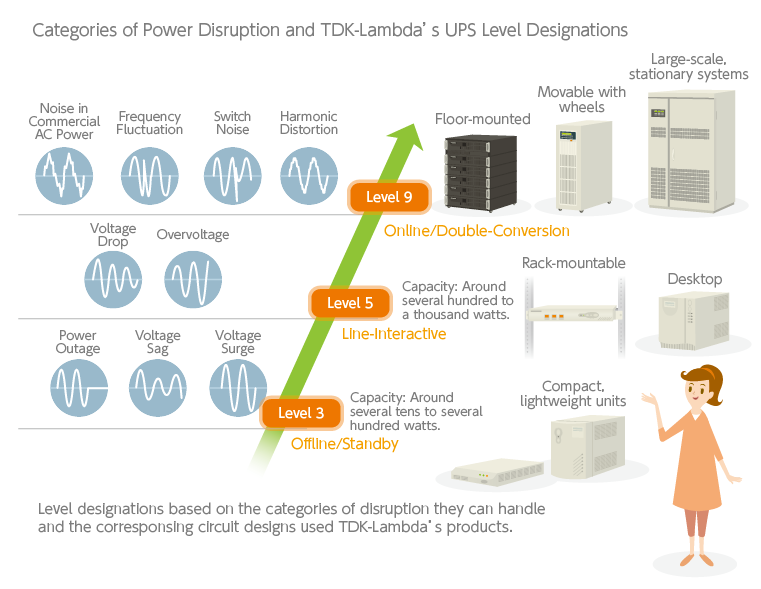
TDK is a comprehensive electronic components manufacturer leading the world in magnetic technology



